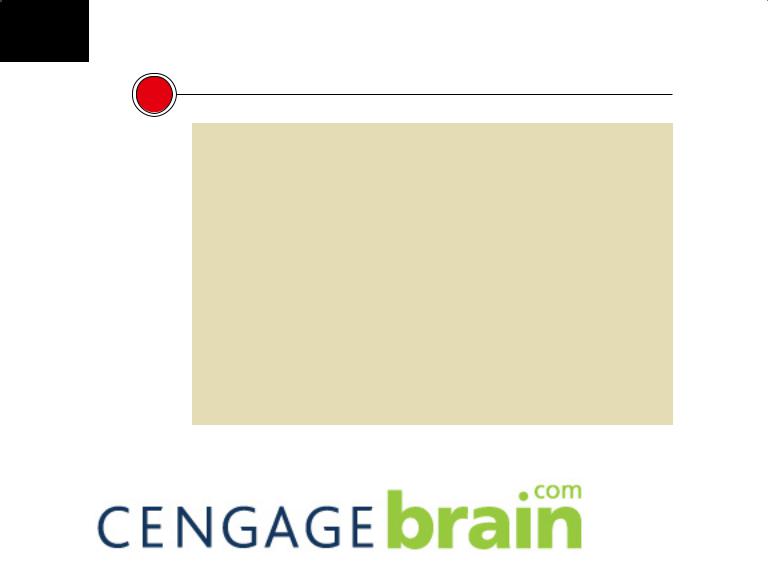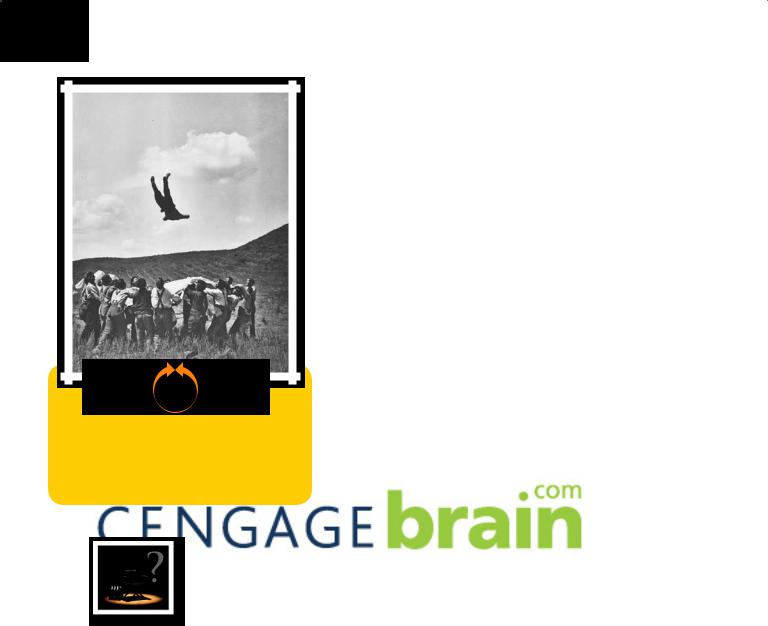
R.Daft Understanding Management
.pdf
Licensed to: CengageBrain User
30 |
Chapter 1 Innovative Management for a Changing World |
1.7
EXHIBIT
Characteristics of Scientific Management
General Approach
•Developed standard method for performing each job
•Selected workers with appropriate abilities for each job
•Trained workers in standard methods
•Supported workers by planning their work and eliminating interruptions
•Provided wage incentives to workers for increased output
Contributions
•Demonstrated the importance of compensation for performance
•Initiated the careful study of tasks and jobs
•Demonstrated the importance of personnel selection and training
Criticisms
•Did not appreciate the social context of work and higher needs of workers
•Did not acknowledge variance among individuals
•Tended to regard workers as uninformed and ignored their ideas and suggestions
© Cengage Learning 2013
Supermarket chains such as Meijer Inc. and Hannaford, for example, use computerized labor waste elimination systems based on scientific management principles. The system breaks down tasks such as greeting a customer, working the register, scanning items, and so forth, into quantifiable units and devises standard times to complete each task. Executives say the computerized system has allowed them to staff stores more efficiently because people are routinely monitored by computer and are expected to meet the strict standards.55
A recent Harvard Business Review article discussing innovations that shaped modern management puts scientific management at the top of its list of 12 influential innovations. Indeed, the ideas of creating a system for maximum efficiency and organizing work for maximum productivity are deeply embedded in our organizations.56 However, because scientific management ignores the social context and workers’ needs, it can lead to increased conflict and clashes between managers and employees. The United Food and Commercial Workers Union, for instance, has filed a grievance against Meijer in connection with its cashier-performance system. Under such performance management systems, workers often feel exploited—a sharp contrast from the harmony and cooperation that Taylor and his followers had envisioned.
Bureaucratic Organizations
A systematic approach developed in Europe that looked at the organization as a whole is the bureaucratic organizations approach, a subfield within the classical perspective. Max Weber (1864–1920), a German theorist, introduced most of the concepts on bureaucratic organizations.57
During the late 1800s, many European organizations were managed on a personal, family-like basis. Employees were loyal to a single individual rather than to the organization or its mission. The dysfunctional consequence of this management practice was that resources were used to realize individual desires rather than organizational goals. Employees in effect owned the organization and used resources for their own gain rather than to serve customers. Weber envisioned organizations that would be managed on an impersonal, rational basis. This form of organization was called a bureaucracy.
Copyright 2012 Cengage Learning. All Rights Reserved. May not be copied, scanned, or duplicated, in whole or in part. Due to electronic rights, some third party content may be suppressed from the eBook and/or eChapter(s). Editorial review has deemed that any suppressed content does not materially affect the overall learning experience. Cengage Learning reserves the right to remove additional content at any time if subsequent rights restrictions require it.

Licensed to: CengageBrain User
Classical Perspective |
31 |
Spotlight ON SKILLS
Are You a New-Style or an Old-Style Manager?
© Bata Zivanovic, Shutterstock
T |
he following are various behaviors in which a |
and rate each one Mostly True or Mostly False |
|
manager may engage when relating to sub- |
to reflect the extent to which you would use that |
||
|
|||
|
ordinates. Read each statement carefully |
behavior. |
|
|
|
Mostly TRUE <<< >>> Mostly FALSE |
|
|
|
1.I feel I am the one responsible to set goals and deadlines for my subordinates.
2.I make sure there are adequate controls in place, so that my subordinates will do the job right.
3.I watch my subordinates closely, because it makes them work harder.
4.Every day I make sure I check with my subordinates to see if they need any help from me.
5. |
It is the manager’s job to plan out work for subordinates. |
|
|
|
See It |
|
|
||||
6. |
If I see my subordinate’s work quality is falling, I intervene immediately. |
|
|
|
Online |
|
|
|
|
7. A good manager will have frequent meetings to keep up on what is happening. 8. The best managers aren’t afraid to push their people to meet deadlines.
Scoring and Interpretation: Add the total number of Mostly True answers and mark your score on the scale below. Theory X tends to be “old-style” management and Theory Y “new-style,” because the styles are based on different assumptions about people. To learn more about these assumptions, you can refer to Exhibit 1.8 and review the assumptions related to Theory X and Theory Y. Strong Theory X assumptions are typically considered inappropriate for today’s workplace. Where do you fit on the X–Y scale? Does your score reflect your perception of yourself as a current or future manager?
X–Y Scale
Theory X 10 5 0 Theory Y
Weber believed that an organization based on rational authority would be more efficient and adaptable to change, because continuity is related to formal structure and positions rather than to a particular person, who may leave or die. To Weber, rationality in organizations meant employee selection and advancement based not on whom you know, but rather on competence and technical qualifications, which are assessed by examination or according to training and experience. The organization relies on rules and written records for continuity. In addition, rules and procedures are impersonal and applied uniformly to all employees. A clear division of labor arises from distinct definitions of authority and responsibility, legitimized as official duties. Positions are organized in a hierarchy, with each position under the authority of a higher one. The manager depends not on her personality for successfully giving orders but on the legal power invested in the managerial position.
The term bureaucracy has taken on a negative meaning in today’s organizations and is associated with endless rules and red tape. We have all been frustrated by waiting in long lines or following seemingly silly procedures. However, rules and other bureaucratic procedures provide a standard way of dealing with employees. Everyone gets equal treatment, and everyone knows what the rules are. This foundation enables many organizations to become extremely efficient. Consider United Parcel Service (UPS), sometimes called Big Brown.
Copyright 2012 Cengage Learning. All Rights Reserved. May not be copied, scanned, or duplicated, in whole or in part. Due to electronic rights, some third party content may be suppressed from the eBook and/or eChapter(s). Editorial review has deemed that any suppressed content does not materially affect the overall learning experience. Cengage Learning reserves the right to remove additional content at any time if subsequent rights restrictions require it.

Licensed to: CengageBrain User
32 |
Chapter 1 Innovative Management for a Changing World |
United
Parcel
Service
(UPS)
UPS delivers more than 15 million packages every business day and is also a leader in air service, logistics, and global information services. The company operates in more than 200 countries and territories around the world.
Why has UPS been so successful? One important factor is the concept of bureaucracy. UPS operates according to strict rules and regulations. It teaches drivers an astounding 340 steps for how to correctly deliver a package—such as how to load the truck, how to fasten their seat belts, how to walk, and how to carry their keys. Specific safety rules apply to drivers, loaders, clerks, and managers. Strict dress codes are enforced—clean uniforms (called browns), every day, black or brown polished shoes with nonslip soles, no beards, no hair below the collar, no tattoos visible during deliveries, and so on. Before each shift, drivers conduct a “Z-scan,” a Z-shaped inspection of the sides and front of their vehicles. Employees are asked to clean off their desks at the end of each day so they can start fresh the next morning. Managers are given copies of policy books with the expectation that they will use them regularly, and memos on various policies and rules circulate by the hundreds every day.
UPS has a well-defined division of labor. Each plant consists of specialized drivers, loaders, clerks, washers, sorters, and maintenance personnel. UPS thrives on written records, and it has been a leader in using new technology to enhance reliability and efficiency. All drivers have daily worksheets that specify performance goals and work output. Technical qualification is the criterion for hiring and promotion. The UPS policy book says the leader is expected to have the knowledge and capacity to justify the position of leadership. Favoritism is forbidden. The bureaucratic model works just fine at UPS, “the tightest ship in the shipping business.”58
What would it be like for you to be a manager in a bureaucratic organization? Complete the Self-Learning instrument on page 43, to find out whether you would thrive in that type of environment.
Administrative Principles
Another major subfield within the classical perspective is known as the administrative principles approach. Whereas scientific management focused on the productivity of the individual worker, the administrative principles approach focused on the total organization. The major contributor to this approach was Henri Fayol (1841–1925), a French mining engineer who worked his way up to become head of a large mining group known as Comambault. Parts of Comambault survive today as a division of Usinor, a French government-owned metallurgical group. In his later years, Fayol wrote down his concepts on administration, based largely on his own management experiences.59
In his most significant work, General and Industrial Management, Fayol discussed 14 general principles of management, several of which are part of management philosophy today. For example:
•Unity of command. Each subordinate receives orders from one—and only one—superior.
•Division of work. Managerial work and technical work are amenable to specialization to produce more and better work with the same amount of effort.
•Unity of direction. Similar activities in an organization should be grouped together under one manager.
•Scalar chain. A chain of authority extends from the top to the bottom of the organization and should include every employee.
Fayol felt that these principles could be applied in any organizational setting. He also identified five basic functions or elements of management: planning, organizing, commanding, coordinating, and controlling. These functions underlie much of the general approach to today’s management theory.
The overall classical perspective as an approach to management was very powerful and gave companies fundamental new skills for establishing high productivity and effective treatment of employees. Indeed, the United States surged ahead of the world in management techniques, and other countries, especially Japan, borrowed heavily from American ideas.
Copyright 2012 Cengage Learning. All Rights Reserved. May not be copied, scanned, or duplicated, in whole or in part. Due to electronic rights, some third party content may be suppressed from the eBook and/or eChapter(s). Editorial review has deemed that any suppressed content does not materially affect the overall learning experience. Cengage Learning reserves the right to remove additional content at any time if subsequent rights restrictions require it.

Licensed to: CengageBrain User
Humanistic Perspective |
33 |
•The study of modern management began in the late nineteenth century with the classical perspective, which took a rational, scientific approach to management and sought to make organizations efficient operating machines.
•Scientific management is a subfield of the classical perspective that emphasizes scientifically determined changes in management practices as the solution to improving labor productivity.
•Frederick Winslow Taylor is known as the father of scientific management.
•Scientific management is considered one of the most significant innovations influencing modern management.
•Some supermarket chains are using computerized systems based on scientific management principles to schedule employees for maximum efficiency.
•Another subfield of the classical perspective is the bureaucratic organizations approach, which emphasizes management on an impersonal, rational basis through elements such as clearly defined authority and responsibility, formal record keeping, and separation of management and ownership.
•Max Weber introduced most of the concepts on bureaucratic organizations.
•Administrative principles is a subfield of the classical perspective that focuses on the total organization rather than the individual worker and delineates the management functions of planning, organizing,
commanding, coordinating, and controlling.
•Henri Fayol, a major contributor to the administrative principles approach, outlined 14 general principles of management, several of which are a part of management philosophy today.
Humanistic Perspective
The humanistic perspective on management emphasized the importance of understanding human behaviors, needs, and attitudes in the workplace, as well as social interactions and group processes.60 There are three primary subfields based on the humanistic perspective: the human relations movement, the human resources perspective, and the behavioral sciences approach.
Early Advocates
Two early advocates of a more humanistic approach were Mary Parker Follett and Chester Barnard. Mary Parker Follett (1868–1933) was trained in philosophy and political science at what was Radcliffe College. She applied herself in many fields, including social psychology and management. She wrote of the importance of common superordinate goals for reducing conflict in organizations.61 Her work was popular with businesspeople of her day but was often overlooked by management scholars.62 Follett’s ideas served as a contrast to scientific management and are reemerging as applicable for modern managers dealing with rapid changes in today’s global environment. Her approach to leadership stressed the importance of people rather than engineering techniques. She offered the pithy admonition, “Don’t hug your blueprints,” and analyzed the dynamics of management-organization interactions. Follett addressed issues that are timely today, such as ethics, power, and how to lead in a way that encourages employees to give their best. The concepts of empowerment, facilitating rather than controlling employees, and allowing employees to act depending on the authority of the situation opened new areas for theoretical study by Chester Barnard and others.63
Copyright 2012 Cengage Learning. All Rights Reserved. May not be copied, scanned, or duplicated, in whole or in part. Due to electronic rights, some third party content may be suppressed from the eBook and/or eChapter(s). Editorial review has deemed that any suppressed content does not materially affect the overall learning experience. Cengage Learning reserves the right to remove additional content at any time if subsequent rights restrictions require it.

Licensed to: CengageBrain User
34 |
Chapter 1 Innovative Management for a Changing World |
National Archives
Chester I. Barnard (1886–1961) studied economics at Harvard but failed to receive a degree because he lacked a course in laboratory science. He went to work in the statistical department of AT&T and in 1927 became president of New Jersey Bell. One of Barnard’s significant contributions was the concept of the informal organization. The informal organization occurs in all formal organizations and includes cliques and naturally occurring social groupings. Barnard argued that organizations are not machines and stressed that informal relationships are powerful forces that can help the organization if properly managed. Another significant contribution was the acceptance theory of authority, which states that people have free will and can choose whether to follow management orders. People typically follow orders because they perceive positive benefit to themselves, but they do have a choice. Managers should treat employees properly because their acceptance of authority may be critical to organization success in important situations.64
Human Relations Movement
ConceptConnection |
The human relations movement was based on the idea that truly |
|
|
|
|
This 1914 photograph |
of a new arrival at |
effective control comes from within the individual worker rather |
a Nebraska planting camp. This initiation was not part of the |
than from strict, authoritarian control.65 This school of thought |
|
formal rules and illustrates the significance of the informal or- |
recognized and directly responded to social pressures for enlight- |
|
ganization described by Barnard. Social values and behav- |
ened treatment of employees. The early work on industrial psy- |
|
iors were powerful forces that could help or hurt the planting |
||
organization depending on how they were managed. |
chology and personnel selection received little attention because |
|
|
|
of the prominence of scientific management. Then a series of |
|
|
studies at a Chicago electric company, which came to be known |
5 |
|
as the Hawthorne studies, changed all that. |
Beginning about 1895, a struggle developed between manufacturers of gas and electric lighting |
||
fixtures for control of the residential and industrial market.66 By 1909, electric lighting had begun to win, but the increasingly efficient electric fixtures used less total power. The electric companies beganacampaigntoconvinceindustrialusersthattheyneededmorelighttogetmoreproductivity. When advertising did not work, the industry began using experimental tests to demonstrate their argument. Managers were skeptical about the results, so the Committee on Industrial Lighting (CIL) was set up to run the tests. To further add to the tests’ credibility, Thomas Edison was made honorarychairmanoftheCIL.Inonetestlocation—theHawthorneplantoftheWesternElectric
Company—some interesting events occurred.
The major part of this work involved four experimental and three control groups. In all, five different tests were conducted. These pointed to the importance of factors other than illumination in affecting productivity. To more carefully examine these factors, numerous other experiments were conducted.67 The results of the most famous study, the first Relay Assembly Test Room (RATR) experiment, were extremely controversial. Under the guidance of two Harvard professors, Elton Mayo and Fritz Roethlisberger, the RATR studies lasted nearly six years (May 10, 1927, to May 4, 1933) and involved 24 separate experimental periods. So many factors were changed and so many unforeseen factors uncontrolled that scholars disagree on the factors that truly contributed to the general increase in performance over that time period. Most early interpretations, however, agreed on one thing: Money was not the cause of the increased output.68 It was believed that the factor that best explained increased output was human relations. Employees performed better when managers treated them in a positive manner. Recent reanalyses of the experiments have revealed
Copyright 2012 Cengage Learning. All Rights Reserved. May not be copied, scanned, or duplicated, in whole or in part. Due to electronic rights, some third party content may be suppressed from the eBook and/or eChapter(s). Editorial review has deemed that any suppressed content does not materially affect the overall learning experience. Cengage Learning reserves the right to remove additional content at any time if subsequent rights restrictions require it.

Licensed to: CengageBrain User
Humanistic Perspective |
35 |
New Manager
Self-Test
Evolution of Style
This questionnaire asks you to describe yourself. For each item, give the number “4” to the phrase that best describes you, “3” to the item that is next best, and on down to “1” for the item that is least like you.
1.My strongest skills are:
_____ a. Analytical skills
_____ b. Interpersonal skills
_____ c. Political skills
_____ d. Flair for drama
2.The best way to describe me is:
_____ |
a. Technical expert |
_____ |
b. Good listener |
_____ |
c. Skilled negotiator |
_____ |
d. Inspirational leader |
3.What has helped me the most to be successful is my ability to:
_____ |
a. Make good decisions |
_____ |
b. Coach and develop people |
_____ |
c. Build strong alliances and a power base |
_____ |
d. Inspire and excite others |
4. What people are most likely to notice about me is my:
_____ |
a. Attention to detail |
|
_____ |
b. Concern for people |
|
_____ |
c. Ability to succeed in the face of conflict and |
|
|
opposition |
|
_____ |
d. Charisma |
|
5. My most important leadership trait is: |
|
|
_____ |
a. Clear, logical thinking |
See It |
_____ |
b. Caring and support for others |
Online |
_____ |
c. Toughness and aggressiveness |
|
_____ |
d. Imagination and creativity |
|
6. I am best described as: |
|
|
_____ |
a. An analyst |
|
_____ |
b. A humanist |
|
_____ |
c. A politician |
|
_____ |
d. A visionary |
|
Interpretation: New managers typically view their world through one or more mental frames of reference. (1) The structural frame of reference sees the organization as a machine that can be economically efficient and that provides a manager with formal authority to achieve goals. This manager frame became strong during the era of scientific management and bureaucratic administration. (2) The human resource frame sees the organization as people, with manager emphasis given to support, empowerment, and belonging. This manager frame gained importance with the rise of the humanistic perspective. (3) The political frame sees the organization as a competition for resources to achieve goals, with manager emphasis on negotiation and hallway coalition building. This frame reflects the need within systems theory to have all parts working together. (4) The symbolic frame of reference sees the organization as theater—a place to achieve dreams—with manager emphasis on symbols, vision, culture, and inspiration. This manager frame is important for learning organizations.
Which frame reflects your way of viewing the world? The first two frames of reference—structural and human resource—are more important for new managers. These two frames usually are mastered first. As new managers gain experience and move up the organization, they should acquire political skills and also learn to use symbols for communication. It is important for new managers not to be stuck for years in one way of viewing the organization because their progress may be limited. Many new managers evolve through and master each of the four frames as they become more skilled and experienced.
Scoring: Higher score represents your way of viewing the organization and will influence your management style. Compute your scores as follows:
ST = 1a + 2a + 3a + 4a + 5a + 6a =
HR = 1b + 2b + 3b + 4b + 5b + 6b =
PL = 1c + 2c + 3c + 4c + 5c + 6c =
SY = 1d + 2d + 3d + 4d + 5d + 6d =
SOUrcE: From Roy G. Williams and Terrence E. Deal, When Opposites Dance (Davies Black, 2003). Used with permission.
© inginsh, Shutterstock
Copyright 2012 Cengage Learning. All Rights Reserved. May not be copied, scanned, or duplicated, in whole or in part. Due to electronic rights, some third party content may be suppressed from the eBook and/or eChapter(s). Editorial review has deemed that any suppressed content does not materially affect the overall learning experience. Cengage Learning reserves the right to remove additional content at any time if subsequent rights restrictions require it.

Licensed to: CengageBrain User
36 |
Chapter 1 Innovative Management for a Changing World |
Before reading on, take the New Manager Self-Test on page 35. This test will give you feedback about how your personal manager frame of reference relates to the human resources and other perspectives described in this chapter.
that a number of factors were different for the workers involved, and some suggest that money may well have been the single most important factor.69 An interview with one of the original participants revealed that just getting into the experimental group had meant a huge increase in income.70
These new data clearly show that money mattered a great deal at Hawthorne. In addition, worker productivity increased partly as a result of the increased feelings of importance and group pride employees felt by virtue of being selected for this important project.71 One unintended contribution of the experiments was a rethinking of field research practices. Researchers and scholars realized that the researcher can influence the outcome of an experiment by being too closely involved with research subjects. This phenomenon has come to be known as the Hawthorne effect in research methodology. Subjects behaved differently because of the active participation of researchers in the Hawthorne experiments.72
From a historical perspective, whether the studies were academically sound is of less importance than the fact that they stimulated an increased interest in looking at employees as more than extensions of production machinery. The interpretation that employees’ output increased when managers treated them in a positive manner started a revolution in worker treatment for improving organizational productivity. Despite flawed methodology or inaccurate conclusions, the findings provided the impetus for the human relations movement. This approach shaped management theory and practice for well over a quartercentury, and the belief that human relations is the best approach for increasing productivity persists today.
Look back at your scores on the questionnaire on newversus old-style management as related to Theory X and Theory Y. How will your management assumptions about people fit into an organization today?
Human Resources Perspective
The human relations movement initially espoused a dairy farm view of management— contented cows give more milk, so satisfied workers will give more work. Gradually, views with deeper content began to emerge. The human resources perspective maintained an interest in worker participation and considerate leadership but shifted the emphasis to consider the daily tasks that people perform. The human resources perspective combines prescriptions for design of job tasks with theories of motivation.73 In the human resources view, jobs should be designed so that tasks are not perceived as dehumanizing or demeaning but instead allow workers to use their full potential. Two of the best-known contributors to the human resources perspective were Abraham Maslow and Douglas McGregor.
Abraham Maslow (1908–1970), a practicing psychologist, observed that his patients’ problems usually stemmed from an inability to satisfy their needs. Thus, he generalized his work and suggested a hierarchy of needs. Maslow’s hierarchy started with physiological needs and progressed to safety, belongingness, esteem, and finally, self-actualization needs. Chapter 16 discusses his ideas in more detail.
Douglas McGregor (1906–1964) had become frustrated with the early simplistic human relations notions while president of Antioch College in Ohio. He challenged both the classical perspective and the early human relations assumptions about human behavior. Based on his experiences as a manager and consultant, his training as a psychologist, and the work of Maslow, McGregor formulated his Theory X and Theory Y, which are explained in Exhibit 1.8.74 McGregor believed that the classical perspective was based on Theory X assumptions about workers. He also felt that a slightly modified version of Theory X fit early human relations ideas. In other words, human relations ideas did not go far enough. McGregor proposed Theory Y as a more realistic view of workers for guiding management thinking.
The point of Theory Y is that organizations can take advantage of the imagination and intellect of all their employees. Employees will exercise self-control and will contribute to
Copyright 2012 Cengage Learning. All Rights Reserved. May not be copied, scanned, or duplicated, in whole or in part. Due to electronic rights, some third party content may be suppressed from the eBook and/or eChapter(s). Editorial review has deemed that any suppressed content does not materially affect the overall learning experience. Cengage Learning reserves the right to remove additional content at any time if subsequent rights restrictions require it.

Licensed to: CengageBrain User
Humanistic Perspective
EXHIBIT
Theory X and Theory Y
Assumptions of Theory X
•The average human being has an inherent dislike of work and will avoid it if possible.
•Because of the human characteristic of dislike for work, most people must be coerced, controlled, directed, or threatened with punishment to get them to put forth adequate effort toward the achievement of organizational objectives.
•The average human being prefers to be directed, wishes to avoid responsibility, has relatively little ambition, and wants security above all.
Assumptions of Theory Y
•The expenditure of physical and mental effort in work is as natural as play or rest. The average human being does not inherently dislike work.
•External control and the threat of punishment are not the only means for bringing about effort toward organizational objectives. A person will exercise self-direction and self-control in the service of objectives to which he or she is committed.
•The average human being learns, under proper conditions, not only to accept but to seek responsibility.
•The capacity to exercise a relatively high degree of imagination, ingenuity, and creativity in the solution of organizational problems is widely, not narrowly, distributed in the population.
•Under the conditions of modern industrial life, the intellectual potentialities of the average human being are only partially utilized.
SOURCE: Douglas McGregor, The Human Side of Enterprise (New York: McGraw-Hill, 1960), pp. 33–48.
organizational goals when given the opportunity. A few companies today still use Theory X management, but many are using Theory Y techniques. Consider how Cisco Systems applies Theory Y assumptions to tap into employee creativity and mind power.
Perhaps surprisingly for an innovative technology company, Cisco Systems started out as a typical hierarchical organization with a command-and-control mind-set. That all changed after the dot-com bubble burst in the early 2000s. Cisco’s stock dropped 86 percent virtually overnight. CEO John Chambers believed the company needed a new
approach to management if it was to survive. He knew collaboration and teamwork would be required to get the company growing again. In addition, Chambers thought employees would be more creative, more productive, and more committed to rebuilding the organization if they had more autonomy and fewer limitations. So, he essentially threw out the old structures and controls. Now, rather than having proposals and suggestions sent to top executives for approval, a network of councils and boards that cross functional, departmental, and hierarchical lines are empowered to launch new businesses. One board made up of volunteer selfidentified “sports freaks” built a product called StadiumVision, which allows venue owners to push video and digital content such as advertising to fans in the stadium. Now a multibilliondollar business, Stadium Vision came together in less than four months, without the CEO ever being involved in the decision.
Command and control is a thing of the past, Chambers asserts, with the future belonging to those companies that build leadership throughout the organization. The Theory Y approach helped Cisco emerge from the dot-com crisis more profitable than ever and the company has since outperformed many technology rivals.75
37
1.8
Cisco
Systems
Copyright 2012 Cengage Learning. All Rights Reserved. May not be copied, scanned, or duplicated, in whole or in part. Due to electronic rights, some third party content may be suppressed from the eBook and/or eChapter(s). Editorial review has deemed that any suppressed content does not materially affect the overall learning experience. Cengage Learning reserves the right to remove additional content at any time if subsequent rights restrictions require it.

Licensed to: CengageBrain User
38 |
Chapter 1 Innovative Management for a Changing World |
Behavioral Sciences Approach
The behavioral sciences approach uses scientific methods and draws from sociology, psychology, anthropology, economics, and other disciplines to develop theories about human behavior and interaction in an organizational setting. This approach can be seen in practically every organization. When a company such as Zappos.com conducts research to determine the best set of tests, interviews, and employee profiles to use when selecting new employees, it is using behavioral science techniques. When Best Buy electronics stores train new managers in the techniques of employee motivation, most of the theories and findings are rooted in behavioral science research.
One specific set of management techniques based in the behavioral sciences approach is organization development (OD). In the 1970s, organization development evolved as a separate field that applied the behavioral sciences to improve the organization’s health and effectiveness through its ability to cope with change, improve internal relationships, and increase problem-solving capabilities.76 The techniques and concepts of organization development have since been broadened and expanded to address the increasing complexity of organizations and the environment, and OD is still a vital approach for managers. OD will be discussed in detail in Chapter 8. Other concepts that grew out of the behavioral sciences approach include matrix organizations, self-managed teams, ideas about corporate culture, and management by wandering around. Indeed, the behavioral sciences approach has influenced the majority of tools, techniques, and approaches that managers have applied to organizations since the 1970s.
All the remaining chapters of this book contain research findings and management applications that can be attributed to the behavioral sciences approach.
•The humanistic perspective emphasized understanding human behavior, needs, and attitudes in the workplace.
•Mary Parker Follett and Chester Barnard were early advocates of a more humanistic approach to management.
•Follett emphasized worker participation and empowerment, shared goals, and facilitating rather than controlling employees. Barnard’s contributions include the acceptance theory of authority.
•The human relations movement stresses the satisfaction of employees’ basic needs as the key to increased productivity.
•The Hawthorne studies were important in shaping ideas concerning how managers should treat workers.
•The human resources perspective suggests that jobs should be designed to meet people’s higher-level needs by allowing employees to use their full potential.
•The behavioral sciences approach draws from psychology, sociology, and other social sciences to develop theories about human behavior and interaction in an organizational setting.
•Many current management ideas and practices can be traced to the behavioral sciences approach.
Quantitative Perspective
World War II caused many management changes. The massive and complicated problems associated with modern global warfare presented managerial decision makers with the need for more sophisticated tools than ever before.The quantitative perspective, also referred to
Copyright 2012 Cengage Learning. All Rights Reserved. May not be copied, scanned, or duplicated, in whole or in part. Due to electronic rights, some third party content may be suppressed from the eBook and/or eChapter(s). Editorial review has deemed that any suppressed content does not materially affect the overall learning experience. Cengage Learning reserves the right to remove additional content at any time if subsequent rights restrictions require it.

Licensed to: CengageBrain User
Recent Historical Trends |
39 |
as management science, provided a way to address those problems. This view is distinguished for its application of mathematics, statistics, and other quantitative techniques to management decision making and problem solving. During World War II, groups of mathematicians, physicists, and other scientists were formed to solve military problems that frequently involved moving massive amounts of materials and large numbers of people quickly and efficiently. Managers soon saw how quantitative techniques could be applied to large-scale business firms.77
Recent Historical Trends
Despite recent heavy use of the quantitative approach by some managers, among the approaches we’ve discussed so far the humanistic perspective has remained most prevalent from the 1950s until today.The post–World War II period saw the rise of new concepts along with a continued strong interest in the human aspect of managing, such as team and group dynamics and other ideas that relate to the humanistic perspective. Three new concepts that appeared were systems thinking, the contingency view, and total quality management.
Systems Thinking
Systems thinking is the ability to see both the distinct elements of a system or situation and the complex and changing interaction among those elements. A system is a set of interrelated parts that function as a whole to achieve a common purpose.78 Subsystems are parts of a system, such as an organization, that depend on one another. Changes in one part of the system (the organization) affect other parts. Managers need to understand the synergy of the whole organization, rather than just the separate elements, and to learn to reinforce or change whole-system patterns.79 Synergy means that the whole is greater than the sum of its parts. The organization must be managed as a coordinated whole. Managers who understand subsystem interdependence and synergy are reluctant to make changes that do not recognize subsystem impact on the organization as a whole.
Many people have been trained to solve problems by breaking a complex system, such as an organization, into discrete parts and working to make each part perform as well as possible. However, the success of each piece does not add up to the success of the whole. In fact, sometimes changing one part
AP Photo/John Raoux
ConceptConnection
Standing in a long, snaking line children isn’t a parent’s idea of a good time. The Walt Disney Company used quantitative techniques to develop FASTPASS, a sophisticated computerized system that spares parents the ordeal for the most popular rides. Disney theme parks have machines that issue coupons with a return time that’s been calculated based on the number of people standing in the actual line, the number who have already obtained passes, and each ride’s capacity.
Copyright 2012 Cengage Learning. All Rights Reserved. May not be copied, scanned, or duplicated, in whole or in part. Due to electronic rights, some third party content may be suppressed from the eBook and/or eChapter(s). Editorial review has deemed that any suppressed content does not materially affect the overall learning experience. Cengage Learning reserves the right to remove additional content at any time if subsequent rights restrictions require it.
